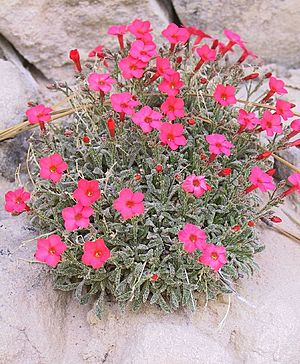Aliciella caespitosa facts for kids
Quick facts for kids Aliciella caespitosa |
|
|---|---|
 |
|
| Conservation status | |
| Scientific classification | |
| Genus: |
Aliciella
|
| Species: |
caespitosa
|
| Synonyms | |
|
Gilia caespitosa |
|
The Aliciella caespitosa is a special kind of flowering plant. It is also known as the Rabbit Valley gilia or Wonderland Alice-flower. This plant belongs to the phlox family. It is found only in Utah, specifically in Wayne County. When a plant is found only in one small area, it is called endemic.
What Does It Look Like?
This plant is a perennial herb. This means it lives for more than two years. It grows in a thick clump of leaves close to the ground. These leaves are a bit sticky. The plant itself only grows a few centimeters tall.
Its flowers are very colorful. They can be bright scarlet (a deep red) or blue-purple. Sometimes, the flowers change color as they get older. They might fade to a darker maroon or purple shade. You can see these flowers blooming in June and July. The plant then makes seeds in July and August.
Where Does It Live?
This unique plant grows in sandy places. It likes rocky slopes and cracks in rocks. You can often find it in areas with Navajo and Wingate Sandstone rocks. These areas are often pinyon-juniper woodlands. Sometimes, it grows near sagebrush plants or Ponderosa pine trees.
Scientists first found this plant in 1875. Then, it wasn't seen again for 90 years! Today, there are about 6 main groups of these plants. These groups are spread across 40 different spots. In total, there are about 15,000 to 25,000 individual plants. All of them live within a small area of about 90 square kilometers in Wayne County, Utah.
Protecting This Plant
Even though many of these plants grow in places that are hard to reach, they still face some dangers. One threat is poaching. This means people might try to illegally dig up the plants to sell them. They might want them for gardens or plant collections.
Other threats come from human activities. When highways are made wider, it can destroy the plant's habitat. Also, mining for sand and sandstone in the area can harm the places where this plant grows. Protecting these areas helps keep the Aliciella caespitosa safe.
See Also


